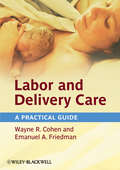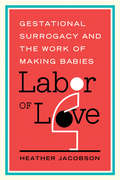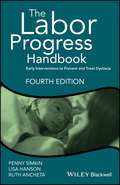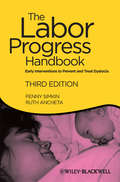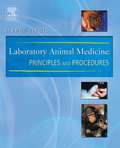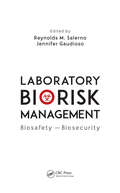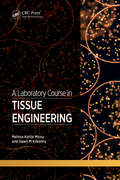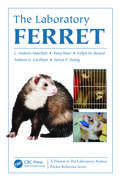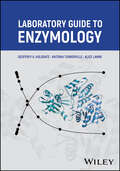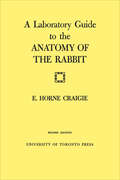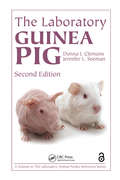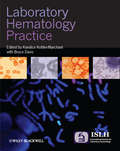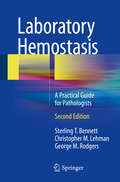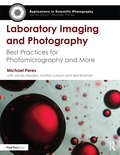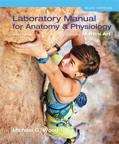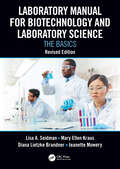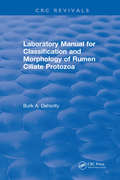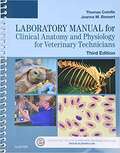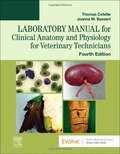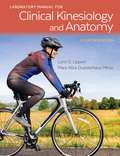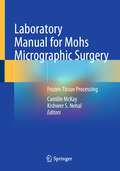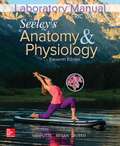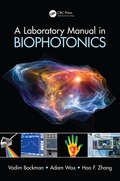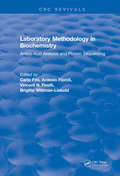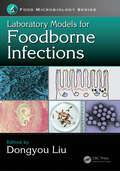- Table View
- List View
Labor and Delivery Care
by Wayne R. Cohen Emanuel A. FriedmanLabor and Delivery Care: A Practical Guide supports and reinforces the acquisition of the practical obstetric skills needed for aiding a successful birth.Beginning with the most important element of successful labor care, communicating with the patient, the authors guide you through normal delivery routines and examination techniques. They then address the best approaches to the full range of challenges that can arise during labor and delivery. Throughout, the 15 chapters provide concise practical guidance with:algorithmic decision treesclinical management tipsdetailed drawingsLabor and Delivery Care: A Practical Guide provides a thorough tour-de-force of the practical obstetric skills needed for best and safest practice based on clinical experience and evidence.
Labor of Love: Gestational Surrogacy and the Work of Making Babies
by Heather JacobsonWhile the practice of surrogacy has existed for millennia, new fertility technologies have allowed women to act as gestational surrogates, carrying children that are not genetically their own. While some women volunteer to act as gestational surrogates for friends or family members, others get paid for performing this service. The first ethnographic study of gestational surrogacy in the United States, Labor of Love examines the conflicted attitudes that emerge when the ostensibly priceless act of bringing a child into the world becomes a paid occupation. Heather Jacobson interviews not only surrogate mothers, but also their family members, the intended parents who employ surrogates, and the various professionals who work to facilitate the process. Seeking to understand how gestational surrogates perceive their vocation, she discovers that many regard surrogacy as a calling, but are reluctant to describe it as a job. In the process, Jacobson dissects the complex set of social attitudes underlying this resistance toward conceiving of pregnancy as a form of employment. Through her extensive field research, Jacobson gives readers a firsthand look at the many challenges faced by gestational surrogates, who deal with complicated medical procedures, delicate work-family balances, and tricky social dynamics. Yet Labor of Love also demonstrates the extent to which advances in reproductive technology are affecting all Americans, changing how we think about maternity, family, and the labor involved in giving birth. For more, visit http://www.heatherjacobsononline.com/
The Labor Progress Handbook: Early Interventions to Prevent and Treat Dystocia
by Lisa Hanson Penny Simkin Ruth AnchetaPraise for the previous edition: "This…edition is timely, useful, well organized, and should be in the bags of all doulas, nurses, midwives, physicians, and students involved in childbirth."–Journal of Midwifery and Women's Health The Labor Progress Handbook: Early Interventions to Prevent and Treat Dystocia is an unparalleled resource on simple, non-invasive interventions to prevent or treat difficult or prolonged labor. Thoroughly updated and highly illustrated, the book shows how to tailor one’s care to the suspected etiology of the problem, using the least complex interventions first, followed by more complex interventions if necessary. This new edition now includes a new chapter on reducing dystocia in labors with epidurals, new material on the microbiome, as well as information on new counselling approaches specially designed for midwives to assist those who have had traumatic childbirths. Fully referenced and full of practical instructions throughout, The Labor Progress Handbook continues to be an indispensable guide for novices and experts alike who will benefit from its concise and accessible content.
The Labor Progress Handbook
by Penny Simkin Ruth AnchetaThe third edition of The Labor Progress Handbook builds on the success of first two editions and remains an unparalleled resource on simple, non-invasive interventions to prevent or treat difficult labor. Features new to this edition include two new chapters on third and fourth stage labor management and low-technology interventions, a complete analysis of directed versus spontaneous pushing, and additional information on massage techniques.
Laboratory Animal Medicine: Principles and Procedures
by Margi SiroisComprehensive coverage of a variety of topics such as animal species, the laboratory setting, regulatory guidelines, and ethical considerations prepares readers for a career in laboratory animal medicine. Familiarizes readers with the handling, behavior, nutrition, and lab and treatment procedures for a large variety of common and nontraditional laboratory animals. The consistent organization of each species chapter makes it easy for readers to quickly identify similarities and differences among various laboratory animals. Laboratory exercises are included in a perforated section at the end of the book, allowing users to apply their knowledge and develop job skills. Features a wealth of user-friendly features such as a two-color design, learning objectives, key points, and review questions. Provides detailed information on specific legal and ethical requirements of lab animal care and use, including the ethics of pain management. Convenient boxes and tables provide quick access to,important anatomic and physiologic data for each species.
Laboratory Biorisk Management: Biosafety and Biosecurity
by Reynolds M. Salerno Jennifer GaudiosoOver the past two decades bioscience facilities worldwide have experienced multiple safety and security incidents, including many notable incidents at so-called "sophisticated facilities" in North America and Western Europe. This demonstrates that a system based solely on biosafety levels and security regulations may not be sufficient.Setting the s
A Laboratory Course in Tissue Engineering
by Melissa Kurtis Micou Dawn KilkennyFilling the need for a lab textbook in this rapidly growing field, A Laboratory Course in Tissue Engineering helps students develop hands-on experience. The book contains fifteen standalone experiments based on both classic tissue-engineering approaches and recent advances in the field. Experiments encompass a set of widely applicable techniques: c
The Laboratory Ferret (Laboratory Animal Pocket Reference)
by C. Andrew Matchett Rena Marr Felipe M. Berard Andrew G. Cawthon Sonya P. SwingLaboratory animals, including ferrets, play an important role in biomedical research and advances. The humane care and management of these animals remains an ongoing concern. Published in color to provide greater clarity to the techniques and concepts discussed, The Laboratory Ferret presents basic information and common procedures in detail to pro
Laboratory Guide to Enzymology
by Geoffrey A. Holdgate Antonia Turberville Alice LanneLABORATORY GUIDE TO ENZYMOLOGY An accessible guide to understanding the foundations of enzymology at its application in drug discovery Enzymes are highly specialized proteins necessary for performing specific biochemical reactions essential for life in all organisms. In disease, the functioning of these enzymes can become altered and, therefore, enzymes represent a large class of key targets for drug discovery. In order to successfully target dysfunctional enzymes pharmaceutically, the unique mechanism of each enzyme must be understood through thorough and in-depth kinetic analysis. The topic of enzymology can appear challenging due its interdisciplinary nature combining concepts from biology, chemistry, and mathematics. Laboratory Guide to Enzymology brings together the theory of enzymology and associated lab-based work to offer a practical, accessible guide encompassing all three scientific disciplines. Beginning with a brief introduction to proteins and enzymes, the book slowly immerses the reader into the foundations of enzymology and how it can be used in drug discovery using modern methods of experimentation. The result is a detailed but highly readable volume detailing the basis of drug discovery research. Laboratory Guide to Enzymology readers will also find: Descriptions of key concepts in enzymology Examples of drugs targeting different enzymes via different mechanisms Detailed discussion about many areas of enzymology such as binding and steady-state kinetics, assay development, and enzyme inhibition and activation Laboratory Guide to Enzymology is ideal for all pharmaceutical and biomedical researchers working in enzymology and assay development, as well as advanced students in the biochemical or biomedical sciences looking to develop a working knowledge of this field of research.
A Laboratory Guide to the Anatomy of The Rabbit: Second Edition
by Edward CraigieThe present work does not in any way aim to replace Bensley's Practical Anatomy of the Rabbit, which has long since proved its value beyond question. The attempt has been to meet a need for a shorter and less detailed laboratory guide adapted to courses for which Bensley's Anatomy has been found too extensive. Classes for which the present book is designed have assignments of time for this subject varying from about twenty-four hours to about sixty hours. Some of them have two-hour periods and some have three-hour periods. Some, moreover, have need for special emphasis on certain parts which are of less immediate interest to others. Of the twenty-eight illustrations, fifteen are new and the remainder have been borrowed from Bensley's Practical Anatomy. Four of the latter were the work of the late Dr. Bensley, the rest were prepared by the present author.
The Laboratory Guinea Pig
by Donna J. Clemons Jennifer L. SeemanLaboratory animals play an important role in biomedical research and advances. Expanded, updated, and now published in full color to provide greater clarity to the techniques and concepts discussed, this guide presents basic information and common procedures in detail to provide a quick reference for investigators, technicians, and caretakers in the laboratory setting. It includes additional information on the research uses of the guinea pig along with updated medical care information.
Laboratory Hematology Practice
by Bruce Davis Kandice Kottke-MarchantExpertly edited and endorsed by the International Society for Laboratory Hematology, this is the newest international textbook on all aspects of laboratory hematology. Covering both traditional and cutting-edge hematology laboratory technology this book emphasizes international recommendations for testing practices. Illustrative case studies on how technology can be used in patient diagnosis are included. Laboratory Hematology Practice is an invaluable resource for all those working in the field.
Laboratory Hemostasis
by Sterling T. Bennett Christopher M. Lehman George M. RodgersCoagulation testing is the basis for the diagnosis of bleeding and thrombotic disorders, as well as the mainstay of anticoagulant monitoring and management. This handbook provides practical information and guidance on topics relevant to directing a coagulation laboratory, filling a void in the literature. Since the first edition, all chapters have been updated and an entirely new chapter is included on pharmacogenomics and pharmacogenetics. The book will aid pathologists, clinical laboratory scientists and other physicians serving as laboratory directors to understand and carry out their responsibilities. It will also assist residents and fellows in learning the basics of coagulation testing and serve as a useful day-to-day reference for coagulation laboratory supervisors, technologists, and technicians. Finally, clinicians may find aspects of the book helpful in understanding the role of the coagulation laboratory in patient evaluation and monitoring.
Laboratory Imaging & Photography: Best Practices for Photomicrography & More (Applications in Scientific Photography)
by Michael PeresLaboratory Imaging and Photography: Best Practices for Photomicrography and More is the definitive guide to the production of scientific images. Inside, the reader will find an overview of the theory and practice of laboratory photography, along with useful approaches to choosing equipment, handling samples, and working with microscopic subjects. Drawing from over 150 years of combined experience in the field, the authors outline methods of properly capturing, processing and archiving the images that are essential to scientific research. Also included are chapters on applied close-up photography, artificial light photography and the optics used in today’s laboratory environment, with detailed entries on light, confocal and scanning electron microscopy. A lab manual for the digital era, this peerless reference book explains how to record visual data accurately in an industry where a photograph can serve to establish a scientific fact. Key features include: Over 200 full-color photographs and illustrations A condensed history of scientific photography Tips on using the Adobe Creative Suite for scientific applications A cheat sheet of best practices Methods used in computational photography
Laboratory Manual For Anatomy And Physiology Featuring Martini Art, Main Version
by Michael WoodThis laboratory manual is designed to serve the lab course that accompanies the two-semester anatomy and physiology lecture course. It provides students with comprehensive coverage of anatomy and physiology, beautiful full-color art and photographs, and an intuitive pedagogical framework. The primary goals of this manual are to provide students with hands-on experiences that reinforce the information they learn in the lecture course and to help them understand three-dimensional relationships, visualize complex structures, and comprehend intricate physiological processes. The manual is written to correspond to all current two-semester anatomy and physiology textbooks, although those students and instructors using Fundamentals of Anatomy & Physiology, Tenth Edition, by Frederic H. Martini, Judi L. Nath, and Edwin F. Bartholomew will recognize here some of the superb art from that text by William Ober and Claire Garrison, Martini's renowned biomedical illustrators. This sixth edition manual is available in three separate versions. The Main Version covers the full two-semester A&P curriculum, including dissections of the cow eye and of the sheep heart, brain, and kidney. The Cat Version includes all of the same material plus an additional section of nine cat dissection exercises encompassing the major body systems. The Pig Version, similarly, includes all of the material from the Main Version with a separate section of nine fetal pig dissection exercises. The Cat and Pig Versions make the manual more useful to instructors whose students perform animal dissections in the lab. The outstanding dissections and accompanying photographs are by Shawn Miller and Mark Neilsen and I thank each of them for their expertise.
Laboratory Manual for Biotechnology and Laboratory Science: The Basics, Revised Edition
by Lisa A. Seidman Mary Ellen Kraus Diana Lietzke Brandner Jeanette MoweryProvides the basic laboratory skills and knowledge to pursue a career in biotechnology. Written by four biotechnology instructors with over 20 years of teaching experience, it incorporates instruction, exercises, and laboratory activities that the authors have been using and perfecting for years. These exercises and activities help students understand the fundamentals of working in a biotechnology laboratory. Building skills through an organized and systematic presentation of materials, procedures, and tasks, the manual explores overarching themes that relate to all biotechnology workplaces including forensic, clinical, quality control, environmental, and other testing laboratories. Features: • Provides clear instructions and step-by-step exercises to make learning the material easier for students. • Emphasizes fundamental laboratory skills that prepare students for the industry. • Builds students’ skills through an organized and systematic presentation of materials, procedures, and tasks. • Updates reflect recent innovations and regulatory requirements to ensure students stay up to date. • Supplies skills suitable for careers in forensic, clinical, quality control, environmental, and other testing laboratories.
Laboratory Manual for Classification and Morphology of Rumen Ciliate Protozoa
by B.A. DehorityThe only rumen protozoa lab guide featuring line drawings created by a leading scientist in the fieldLaboratory Manual for Classification and Morphology of Rumen Ciliate Protozoa is a unique lab guide for learning how to count and identify rumen protozoa. In this guide, Professor Dehority has created line drawings of rumen protozoa that emphasize morphological features and size measurements. The book also provides keys for identifying genera and species, and it contains classifications and descriptions of the different orders and families of rumen ciliate protozoa. Procedures for counting rumen protozoa and identifying individual species are included as well.Laboratory Manual for Classification and Morphology of Rumen Ciliate Protozoa will be an excellent identification guide for protozoologists, microbiologists, dairy scientists, and any researcher or student working with rumen protozoa.
Laboratory Manual for Clinical Anatomy and Physiology for Veterinary Technicians
by Thomas Colville Joanna M. BassertLearn to apply your A&P learning in the lab setting with Colville and Bassert’s Lab Manual for Clinical Anatomy and Physiology for Veterinary Technicians, 3rd Edition. This practical laboratory resource features a variety of activities, such as crossword puzzles, , terminology exercises, illustration identification and labeling, case presentations, and more to help reinforce your understanding of veterinary anatomy and physiology. The lab manual also features vivid illustrations, lists of terms and structures to be identified, and step-by-step dissection guides to walk you through the dissection process. <P><P> Clinically-oriented learning exercises help readers become familiar with the language of anatomy and physiology as you identify structures and learn concepts. Clear step-by-step dissection instructions for complex organs such as the heart familiarize readers with the dissection process in a very visual, easy-to-understand format. Learning objectives, the clinical significance of the content, and lists of terms and structures to be identified appear at the beginning of each chapter. Comprehensive glossary appears at the end of the lab manual and provides accurate, concise. High quality, full color illustrations provides a firm understanding of the details of anatomic structure. Review activities and study exercises are included in every chapter to reinforce important information. Clinical Application boxes are threaded throughout the lab manual and demonstrate the clinical relevance of anatomic and physiologic principles. Companion Evolve site includes answers to the Test Yourself questions in the textbook and crossword puzzles. NEW! Overview at a Glance sections outline the main proficiencies of each chapter and include a list of all exercises in the chapter.
Laboratory Manual for Clinical Anatomy and Physiology for Veterinary Technicians
by Thomas P. Colville Joanna M. BassertLearn to apply your A&P learning in the lab setting with the Laboratory Manual for Clinical Anatomy and Physiology for Veterinary Technicians, 4th Edition. This practical laboratory resource features a variety of activities, such as terminology exercises, illustration identification and labelling, case presentations, and more to help reinforce your understanding of veterinary anatomy and physiology. The laboratory manual also features vivid illustrations, lists of terms and structures to be identified, and step-by-step dissection guides to walk you through the dissection process. <p><p> Clinically oriented learning exercises introduce you to the language of anatomy and physiology as you identify structures and learn concepts. <p><p>Clear, step-by-step dissection instructions for complex organs such as the heart familiarize you with the dissection process in a very visual, easy-to-understand format. <p><p>Learning objectives, the clinical significance of the content, and lists of terms and structures to be identified appear at the beginning of each chapter. <p><p>Review activities and study exercises are included in every chapter to reinforce important information. <p><p>High-quality, full-color illustrations provide a solid understanding of the details of anatomic structure.
Laboratory Manual For Clinical Kinesiology And Anatomy (Fourth Edition)
by Lynn S. Lippert Mary Alice Duesterhaus MinorDivided into three sections, it will help you to prepare for lab, guide you through lab activities, and serve as an after-lab review that ensures you build a solid knowledge base of kinesiology.
Laboratory Manual for Mohs Micrographic Surgery: Frozen Tissue Processing
by Camille McKay Kishwer S. NehalThis manual provides a thorough and up-to-date reference on the Mohs tissue processing technique. Mohs micrographic surgery is a distinct surgical and tissue processing technique that allows comprehensive margin control for high-risk skin cancers with the highest cure rate. Mohs micrographic surgery entails expertise in Mohs tissue frozen section processing in a fully licensed Mohs laboratory.Laboratory Manual for Mohs Micrographic Surgery Frozen Tissue Processing provides extensive practical guidance on optimal management from the leading experts in the field including perspectives from Mohs technicians, laboratory managers, Mohs surgeons and regulatory affairs. It covers the Mohs lab training curriculum for technicians and Micrographic Surgery and Dermatologic Oncology fellows and therefore is an extremely valuable resource for any healthcare professional in the Mohs micrographic surgery field.
Laboratory Manual for Seeley's Anatomy and Physiology (11th Edition)
by Eric WiseLaboratory Manual For Seeley's Anatomy And Physiology, Eleventh Edition
A Laboratory Manual in Biophotonics
by Vadim Backman Adam Wax Hao F. ZhangBiophotonics is a burgeoning field that has afforded researchers and medical practitioners alike an invaluable tool for implementing optical microscopy. Recent advances in research have enabled scientists to measure and visualize the structural composition of cells and tissue while generating applications that aid in the detection of diseases such as cancer, Alzheimer’s, and atherosclerosis. Rather than divulge a perfunctory glance into the field of biophotonics, this textbook aims to fully immerse senior undergraduates, graduates, and research professionals in the fundamental knowledge necessary for acquiring a more advanced awareness of concepts and pushing the field beyond its current boundaries. The authors furnish readers with a pragmatic, quantitative, and systematic view of biophotonics, engaging such topics as light-tissue interaction, the use of optical instrumentation, and formulating new methods for performing analysis. Designed for use in classroom lectures, seminars, or professional laboratories, the inclusion and incorporation of this textbook can greatly benefit readers as it serves as a comprehensive introduction to current optical techniques used in biomedical applications. Caters to the needs of graduate and undergraduate students as well as R&D professionals engaged in biophotonics research. Guides readers in the field of biophotonics, beginning with basic concepts before proceeding to more advanced topics and applications. Serves as a primary text for attaining an in-depth, systematic view of principles and applications related to biophotonics. Presents a quantitative overview of the fundamentals of biophotonic technologies. Equips readers to apply fundamentals to practical aspects of biophotonics.
Laboratory Methodology in Biochemistry: Amino Acid Analysis and Protein Sequencing
by Carlo FiniProvides information on methodologies and techniques concerning the biochemical laboratory, as well as improvements or advancements made on existing methodologies. Original methodologies for the purification of biological macromolecules and methodologies for metabolic pathways and enzyme kinetics are covered. The application of biochemical and biophysical methodologies for the structural and dynamic characterization of biological macromolecules is considered. The elaboration of automated systems for biochemical research and computer programs for the management and processing of experimental data are both reviewed. Development of instruments and equipment for biochemical research is also presented.
Laboratory Models for Foodborne Infections (Food Microbiology)
by Laszlo Endrenyi Dongyou LiuResulting from ingestion of inappropriately prepared or stored foods containing pathogenic viruses, bacteria, fungi and parasites, foodborne infections have become a significant source of human morbidity and mortality worldwide in recent decades. This may be largely attributable to the remarkable popularity of convenient, ready-to-eat food products, the dramatic expansion of international food trades, and the continuing growth of immuno-suppressed population groups. Although anti-microbial treatments have played a crucial part in the control of foodborne infections in the past, the emergence and spread of anti-microbial resistance render the existing treatments ineffective. Additionally, our limited understanding of the molecular mechanisms of foodborne infections has thwarted our efforts in the development of efficacious vaccines for foodborne pathogens. Given the obvious benefits of laboratory models in foodborne disease research, a great number of experiments have been conducted toward the elucidation of host-pathogen interactions in and pathogenic mechanisms of foodborne infections. Forming part of the Food Microbiology series, Laboratory Models for Foodborne Infections presents a state-of-the-art review of laboratory models that have proven valuable in deciphering the life cycle, epidemiology, immunobiology, and other key aspects of foodborne pathogens. Written by scientists with respective expertise in foodborne pathogen research, each chapter includes a contemporary summary of a particular foodborne viral, bacterial, fungal, or parasitic infection in relation to its life cycle, epidemiology, clinical features, pathogenesis, host-pathogen interactions, and other related aspects. Besides providing a trustworthy source of information for undergraduates and postgraduates in food microbiology, Laboratory Models for Foodborne Infections offers an invaluable guide for scientists and food microbiologists with interest in exploiting laboratory models for detailed study of foodborne infections.
